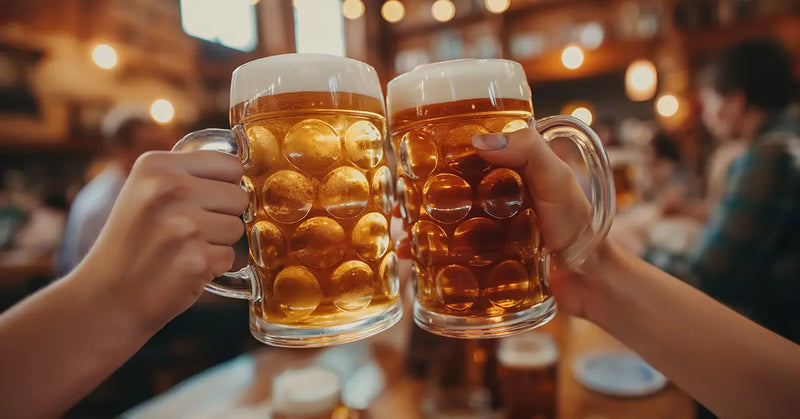
Welcome to the world of two of the most popular beer styles: IPA and Lager. Imagine standing at the bar, menu in hand, deciding between a crisp lager or a hoppy IPA. Both sound appealing, but what exactly sets them apart? If you've ever felt confused by these beer styles, you're not alone. Both IPA and Lager come from different brewing traditions, have unique characteristics, and appeal to different palates. Whether you prefer crisp refreshment or bold hoppy flavours, knowing the difference can help you pick the right pint. Let’s break down the key differences so you’ll know exactly what you’re sipping.
What is a Lager?
The Central European beer style known as lager gets its name from the German word "lagern" (to store). It is made through bottom-fermentation at cool temperatures (45–55°F), which results in a crisp, clean, and refreshing flavour. Lagers have a light to medium body, a slight sweetness from the malt, and little bitterness. Pilsner, Helles, and Bock are popular varieties that usually have an alcohol content of 4-5.5%. They are perfect for relaxed drinking, warm weather, and food pairing because of their smooth finish and golden to pale amber colour. Lagers get their unique refreshing freshness and approachable character from the cold fermentation process. Although the lager category includes many well-known brands like Budweiser and Heineken, craft breweries are also experimenting with different lager varieties.
What is an IPA?
IPA (India Pale Ale) started off in the 1800s in Britain, made with additional hops to preserve beer throughout travels to India. In contrast to lagers, IPAs produce complex flavours and aromas by using top-fermentation at warmer temperatures (60–75°F). A strong hop profile that delivers bitter, citrusy, piney, or flowery notes is what defines hops. New England (hazy and juicy), West Coast (aggressively bitter), and Session (lower alcohol) are popular varieties. IPAs usually have 40–70+ IBUs (International Bitterness Units) and an alcohol content of 5.5%–7.5%. Hop lovers all over the world adore them despite their strong, deep flavour being an acquired taste. This beer style has gained global acceptance thanks to brands like Stone IPA and Sierra Nevada Pale Ale, which have made it a staple of innovative craft brewing.
Key Differences at a Glance
Fermentation Method: IPAs use top-fermenting yeast that works at warmer temperatures, while lagers employ bottom-fermenting yeast that prefers the cold. This fundamental difference influences everything else about these beers.
Flavour Profile: IPAs are hop-forward with bold, bitter, and often fruity or floral notes. Lagers are malt-forward with clean, crisp, and subtly sweet characteristics. The contrast is night and day.
Bitterness Level: IPAs typically measure 40-70+ IBUs (International Bitterness Units), delivering that signature bite. Lagers usually range from 8-30 IBUs, offering gentle, balanced bitterness that doesn't feel too much.
Brewing Time: Lagers require longer brewing and conditioning periods, often 4-8 weeks, due to cold fermentation. IPAs can be ready in 2-3 weeks, making them more popular among craft brewers.
Alcohol Content: IPAs generally pack more punch at 5.5-7.5% ABV (or higher), while most lagers sit comfortably at 4-5.5% ABV, making them sessionable for everyday drinking.
Appearance: While exceptions exist, IPAs often range from golden to deep amber or even hazy orange. Lagers are typically clear and pale golden, though dark lagers like Dunkel break this rule.
Key Differences - A Quick Comparison
To make the difference understood in a simple way, here’s a quick look in tabular format:
|
Aspect |
Lager |
IPA |
|
Fermentation |
Bottom-fermenting yeast at cooler temperatures |
Top-fermenting yeast at warmer temperatures |
|
Flavor |
Crisp, smooth, light, easy to drink |
Bold, hoppy, bitter, aromatic |
|
Alcohol Content |
Generally lower (around 4–5%) |
Usually higher (5–7% or more) |
|
Appearance |
Pale yellow to amber |
Golden to deep amber |
|
Popularity |
Widely consumed globally, mainstream |
Craft beer favourite, popular among hop lovers |
|
Food Pairing |
Burgers, pizza, fried foods |
Spicy dishes, BBQ, strong cheeses |
Ideal Food Pairings
Best Foods to Pair with IPAs:
-
Spicy Dishes: Indian curries, Thai food, and Mexican cuisines, the hops complement the heat beautifully.
-
Grilled & BBQ Meats: Burgers, ribs, and steaks, bitterness cuts through rich, fatty flavours
-
Strong Cheeses: Sharp cheddar, blue cheese, and aged Gouda. Bold flavours match bold beer.
-
Fried Foods: Fish and chips, fried chicken, and onion rings, hops cleanse the palate.
-
Citrus-Based Dishes: Ceviche, citrus-glazed salmon, complementary flavour profiles.
Best Foods to Pair with Lagers:
-
Seafood: Grilled fish, shrimp, oysters, and sushi, clean flavours don't overpower delicate tastes.
-
Light Proteins: Chicken, pork chops, and turkey, crisp beer enhances without competing.
-
Pizza & Pasta: Margherita pizza, carbonara, and lighter Italian dishes make a versatile pairing.
-
Salads & Vegetables: Caesar salad, grilled vegetables, both are refreshing complements to fresh ingredients.
-
Mexican Food: Tacos, burritos, and quesadillas offer a clean finish, balancing spices without being too much.
-
Mild Cheeses: Mozzarella, Havarti, Swiss, subtle flavours work in harmony.
Which One Should You Choose?
Choose an IPA if you:
-
Love bold, complex flavours with pronounced bitterness.
-
Enjoy exploring different hop varieties and aromatic profiles.
-
Want to pair your beer with spicy foods, rich cheeses, or grilled meats.
-
Prefer beers that challenge your palate rather than simply refresh.
-
Those looking for higher alcohol content in their beer.
Choose a Lager if you:
-
Prefer smooth, easy-drinking beers with clean, crisp flavours.
-
Want a refreshing beer for hot days or outdoor activities.
-
Plan to have multiple beers in one sitting (highly sessionable)
-
Need a versatile beer that pairs with lighter fare like seafood, salads, and poultry.
-
Are new to beer and want an approachable starting point.
-
Enjoy beers for social drinking without overwhelming your taste buds.
Still confused? Start with a lager to develop your palate, then gradually explore lighter IPAs like Session or New England styles before diving into bold West Coast varieties. Many craft beer lovers enjoy both styles, depending on their mood and occasions.
FAQs
1. Which is stronger: IPA or lager?
IPAs typically have higher alcohol content, ranging from 5-7% ABV or higher, while most lagers sit between 4-5% ABV. However, this varies by specific style.
2. Why are IPAs more bitter than lagers?
IPAs use significantly more hops during brewing, which creates that characteristic bitter, floral flavour. Lagers use fewer hops, resulting in a milder, more balanced taste.
3. Is IPA or lager easier to drink?
Lagers are generally considered easier to drink due to their crisp, clean taste and lower bitterness. IPAs can be an acquired taste for those new to craft beer.
4. Which beer is better for beginners?
Lagers are typically recommended for beer beginners because of their smooth, approachable flavour profile and lower bitterness levels.
5. Do IPAs and lagers have different calorie counts?
IPAs usually contain more calories (180-250 per 12 oz) due to higher alcohol and residual sugars, while lagers typically range from 140-180 calories per 12 oz.
6. Can you age IPAs like you can some lagers?
Generally, IPAs are best consumed fresh to preserve hop flavours, while certain lagers (especially stronger ones like Bocks) can be aged to develop deeper flavours.
7. Why are IPAs so popular in craft brewing?
IPAs allow brewers to experiment with different hop varieties and create bold, distinctive flavours. Their robust nature also helps them stand out in the crowded craft beer market.
When it comes to IPA vs lager, there’s no winner, just different experiences. Lagers offer crisp refreshment, while IPAs deliver bold, hop-forward flavours. Both styles have earned their place in beer culture, and the best way to decide your favorite is to try them side by side. Whether you're team IPA or team lager, there's a whole world of beer waiting to be explored. Cheers to discovering your next go-to brew!
